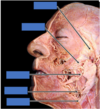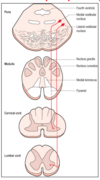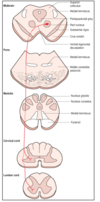Descending Motor Pathways Flashcards
How are motor pathways divided?
Into upper and lower motor neurone regions
They involve a 2 neurone pathway
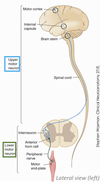
What are the characteristics of upper motor neurones?
Where do they originate from?
Originate in the cerebrum and subcortical structures
they influence lower motor neurone activity
they modify local reflex activity
they superimpose more complex patterns of movement
What are the roles of lower motor neurones?
Where do they originate from?
They originate from the brainstem and the ventral grey horn of the spinal cord
they are peripheral nerves which travel to motor end plates / neuromuscular junctions
they are in direct contact with the muscle
Label the diagram showing a typical lower motor neurone


What type of information is carried by the lower motor neurones?
Afferent nerve:
- visceral sensory and somatic
- these travel in the dorsal root
Efferent nerve:
- somatic motor
- these travel in the ventral root
- the cell body is in the ventral grey horn
What are the 3 main categories of descending motor pathways?
Corticospinal:
- the cell body is in the cortex and it runs to the spinal cord
Corticobulbar / corticonuclear:
- corticobulbar is from the cortex to the brainstem
- corticonuclear is from the cortex to the cranial nerve nuclei in the brainstem
Extrapyramidal:
- these originate in other regions outside of the cerebrum

What are examples of extrapyramidal descending motor pathways?
- reticulospinal - from reticular formation
- rubrospinal
- tectospinal
- vestibulospinal
These are mainly involved in modification of the main pathways elicited in the cortex
In general, what is the pathway like of the corticospinal / corticonuclear descending motor pathway?
- cerebral cortex
- cell bodies in the precentral gyrus
- UMN descends via the internal capsule
- it passes between the cerebral peduncles and through the medullary pyramids
- crosses the midline at the decussation of pyramids
What is the difference between corticonuclear and corticospinal pathways?
corticonuclear:
- from the cortex to the brainstem
- lower motor neurone located in the cranial nerve nuclei for a specific function
corticospinal:
- from the cortex to the spine
- involves spinal nerves
Label the components involved in the corticospinal / corticonuclear descending motor pathway
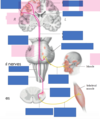

What areas of the somatotopic organisation of descending fibres are missing?


Through which regions of the internal capsule do the corticospinal/nuclear fibres pass through?
the fibres retain somatotopic organisation as they pass through the internal capsule
those travelling to the face travel in the genu
those travelling to the arm, trunk and leg travel in the posterior limb
Label the components of the internal capsule

the posterior limb is located between the thalamus and the lentiform nucleus

Which
What is the difference between the fibres contained within the internal capsule and the crus cerebri (cerebral peduncles)?
the internal capsule also contains ascending sensory fibres that connect to the thalamus
the internal capsule connects to the crus cerebri
the peduncles contain descending fibres only
Label the features of the cerebral peduncles


What is significant about the descending motor fibres within the crus cerebri?
somatotopic representation is still present

Label the location of descending fibres in different parts of the brain

- fibres move from the peduncles, through the basal pons and pyramids
- in the pons, the fibres are interrupted by transpontine fibres
- the fibres recollect to travel in the pyramids of the medulla
- some fibres will cross the midline at the decussation of pyramids

Label the components of the corticospinal tract
Do all the fibres cross at the decussation of pyramids?
What kind of innervation does this produce?

85% of fibres cross at the decussation of pyramids and then enter the lateral corticospinal tract
these produce contralateral innervation
15% of UMNs descend the cord ipsilaterally in the anterior corticospinal tract
these produce bilateral innervation




